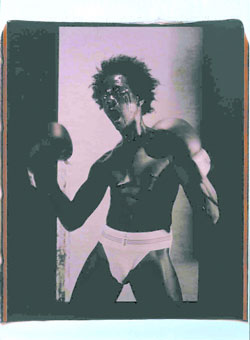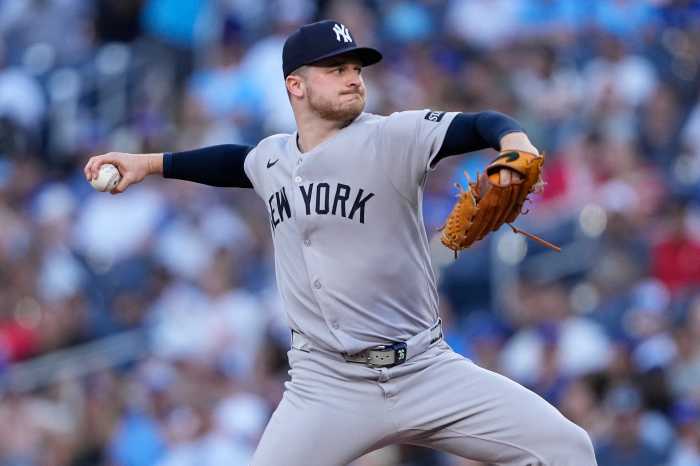VOLUME 2, ISSUE 44 | OCT 30 – NOV 5, 2003
HEALTH
New Paradigm for Men
of Color
New anthology questions aims to reintroduce discussion of HIV risk
When Steven G. Fullwood first read a completed version of “Think Again,” a book he edited with Colin Robinson, he says it was the first time he saw his life represented in print.
“I saw something I had never seen before,” said Fullwood, project director of the Black Gay and Lesbian Archive, housed at Harlem’s Schomburg Center for Research in Black Culture. “I had never seen HIV prevention materials that spoke to my experience. It was always ‘Use a condom and live.’”
The book has work from eleven contributors, including Fullwood. It is meant to change and enliven discussions about how gay and bisexual men of color have sex, form communities, and live. The goal is start a discussion about HIV and these men.
“The passion and the individualism of HIV prevention have been lost,” said Robinson, executive director of the New York State Black Gay Network, a coalition of 17 groups in five cities across the state. “We’re trying to bring meaning and agency back into HIV prevention. It’s about complicating the voices that are available to us.”
Certainly, the circumstances of gay men’s lives have changed. The disease that killed tens of thousands of gay men in New York City in the 80s is seen as less threatening today. Prevention programs do not seem to have changed.
“We want to encourage people to think again about what it means to be at risk,” Robinson said.
He conceived the book last year and he joined forces with George Ayala, director of education at the AIDS Project Los Angeles.
APLA had already begun producing a series of glossy publications for its clients called “Corpus” so it supplied the production expertise. The editorial content was handled in New York. Fullwood was recruited to bring in the contributors and edit.
“Steven made sense because he’s positioned as a popular critic in the black gay community,” Robinson said. “I knew he would bring a kind of popular culture sensibility and he would have the connections as well to bring in the contributors.”
Originally, Robinson had conceived of the book as “people talking from their experience of doing the work, sort of practical experience.”
The book does not directly address HIV prevention throughout, though some of the pieces are critical of current prevention efforts.
“The reality remains that many of the things that we know are effective remain in the toolbox,” Robinson said. “We haven’t been asking and engaging with the right questions.”
There are personal narratives, essays, a short story, and poetry. At times when Robinson and Fullwood spoke about “Think Again” in an October 21 interview they sounded as if they were discussing literature rather than HIV prevention.
“It’s not about the sort of scientific reductionism,” Robinson said.
On the contrary, gay and bisexual black men speak for themselves in “Think Again” after several years of being defined in the mainstream and scientific press as a community overrun with HIV, and spreading it among heterosexuals.
“We wanted to create a text of black, gay men’s lives that is not structured by the media myths of the moment,” Robinson said.
Fullwood ultimately sorted through nearly 20 submissions before deciding on the final eleven. They chose the pieces that were most compelling, but also ones that assure the book would have diverse perspectives.
“The book needed to have multiple voices, voices that speak very candidly about their experiences,” Fullwood said.
Kevin E. Quashie, a contributor who wrote the essay “Everyday Sex,” saw his work as broadening a discussion about sex among gay men that tends to have two elements—safe sex or unsafe sex.
“The conversation about sex, especially for gay, black men, is so much about fear and what not to do and how to protect yourself,” Quashie said. “The counterpoint to that are those men who reject that.”
He wants a discussion that includes all the ambiguity, the fear, the pleasure, and any other elements that might interject themselves into such a conversation. In his essay, Quashie drew an analogy to way the characters on HBO’s “Sex in the City” talk about sex.
“Those women talk about sex all the time even when they are not talking about sex.” he said. “For me there is this wanting to find a way to make sex part of everyday conversation, but not in the ways that it tends to happen.”
The book is appearing as two white gay men—Dan Carlson and Bruce Kellerhouse—are organizing a November 16 town meeting at the Lesbian, Gay, Bisexual and Transgender Community Center to talk about HIV prevention efforts in New York City.
For Robinson, the scheduling of that town meeting is exciting because it could mean that the sort of dialogue he is looking for is beginning. It is also a possible indicator of the failure of prevention.
“It means that people from different places are unhappy,” Robinson said. “Programs seem to have lost meaning.”
Copies of “Think Again” can be downloaded by visiting either nysbgn.org or apla.org. n
Beneath the surface Cover jacket of “Think Again.”


































